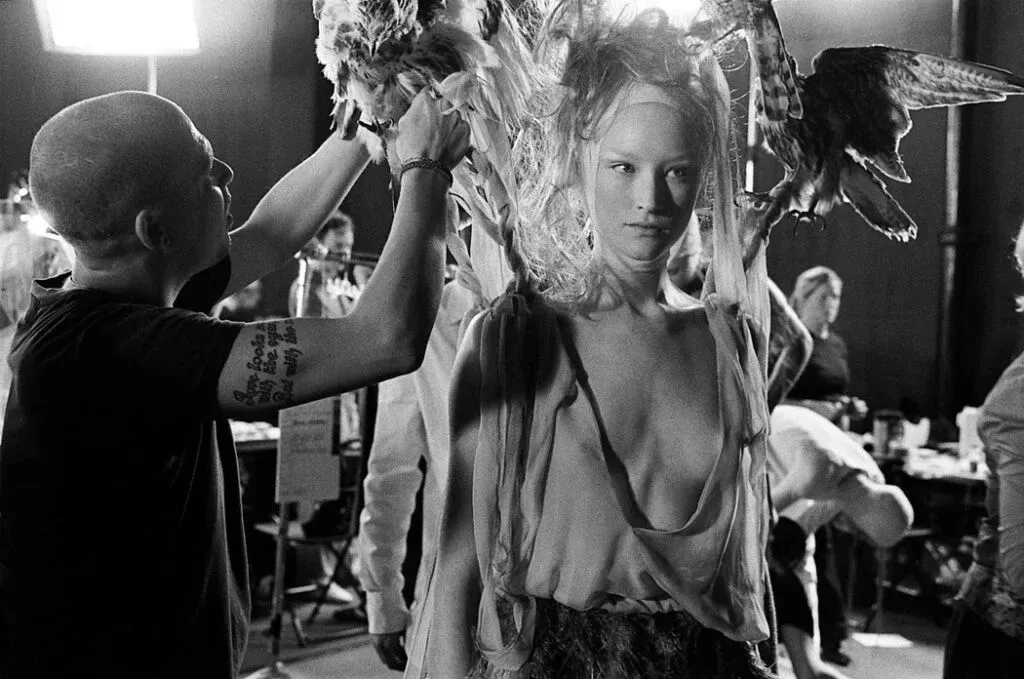
How McQueen Made the Fashion Industry Descend Into Madness
A retrospective look at Alexander McQueen’s ‘Voss’ Collection.
On 26 September 2000, some of the biggest names in fashion, including Anna Wintour and Gwyneth Paltrow, entered Alexander McQueen’s stylised sanatorium at the Gatliff Road Warehouse in London. The audience was immediately enveloped in an eerie atmosphere as they were forced to wait over an hour for the show to begin, sitting opposite a mirrored glass cube with nothing but their reflection and the sound of a slow, continuous heartbeat to keep them occupied. This was a purposeful move by McQueen, pushing his audience into a state of anxiety and stress to make them feel the mental anguish that the models and garments would go on to display during the show.
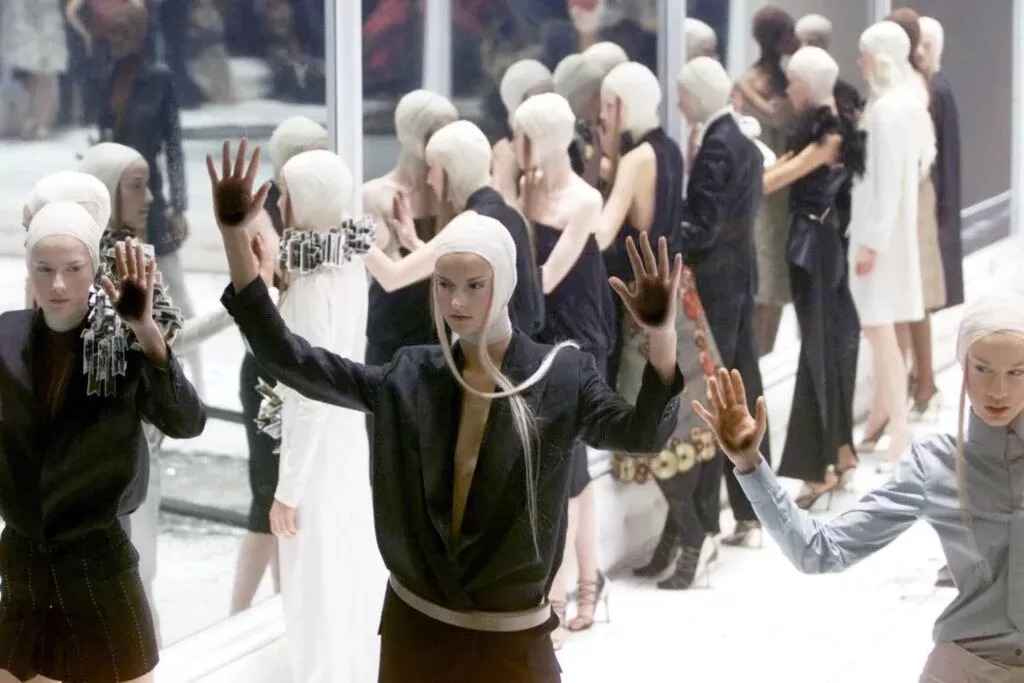
Alexander Mcqueen VSS SS01
When the show finally started, the cube became transparent, revealing a space designed to reflect a stereotypical psychiatric hospital, with glaringly bright white lights and a catwalk of spotless ceramic tiles bordered by padding to evoke the idea of padded rooms.

Alexander McQueen VOSS Japanese silk oyster shells via The Met Museum
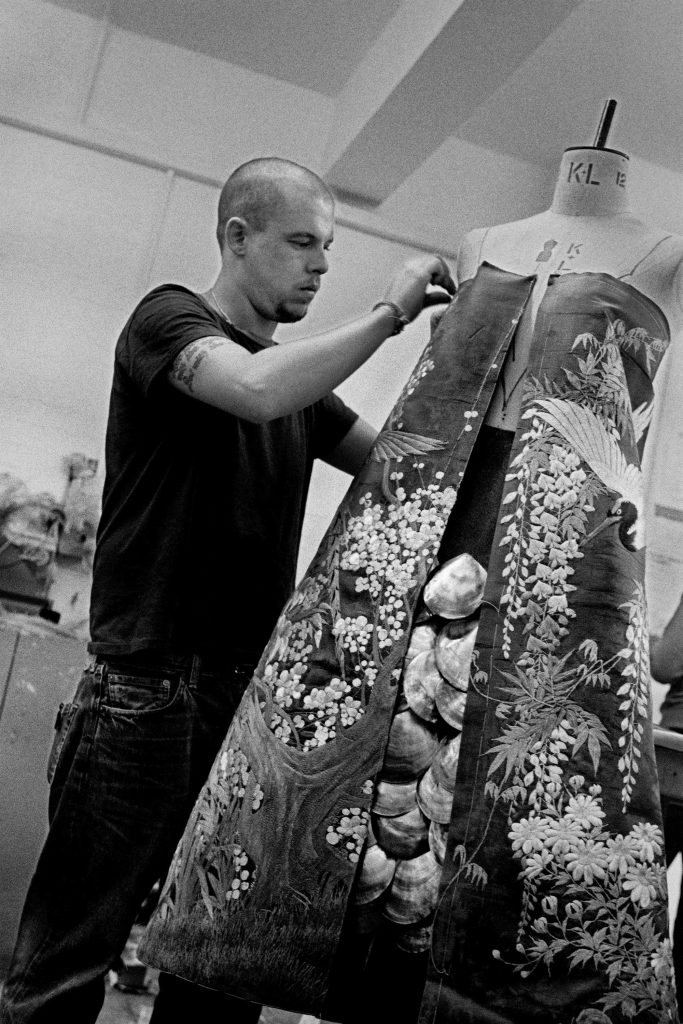
Alexander Mc Queen VOSS – Nss Magazine
Throughout his career, McQueen critiqued the fashion industry through his shows, and Voss was no different. The Spring Summer 2001 collection came at a time when McQueen’s career shifted drastically. He had just left fashion giant Givenchy as head designer, going from being surrounded by a bustling atelier to designing alone and having a lighter workload. It is no secret that McQueen’s time at Givenchy was contentious, between the critiques his collections received and the brand attempting to push him away from his creative style to fit the mould of the house. Ultimately, this took a toll on the late designer, and around this time he appeared to lose a significant amount of weight. The set forced his critics to experience the voyeuristic distress that they subjected him to, with the designer saying himself, “It was a great thing to do in the fashion industry. Turn it back on them!” The models wearing the designs in the box could not see out to the audience, which stripped them of their visibility, a metaphor for how McQueen would give everything to the industry while receiving nothing in return.
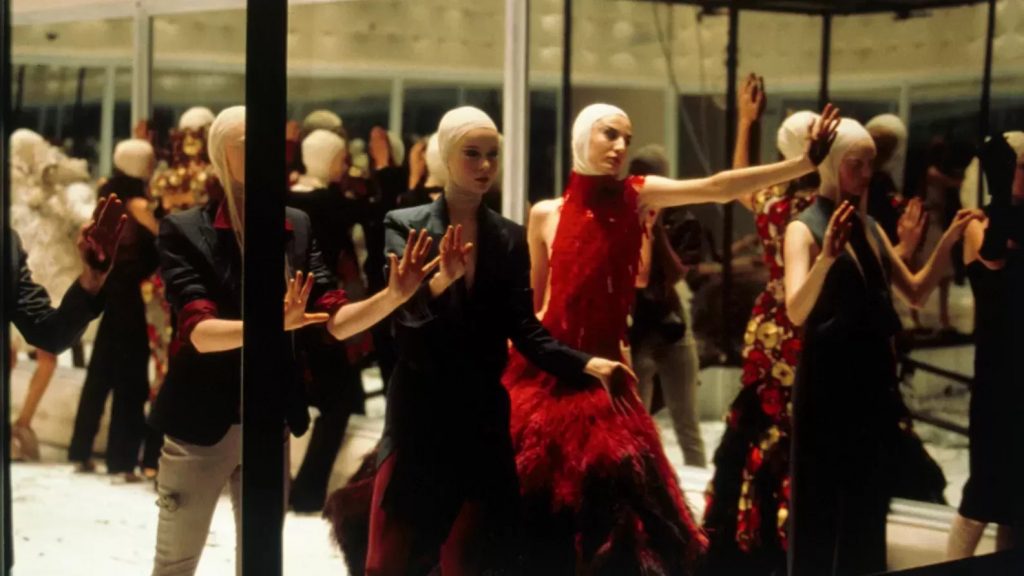
Alexander Mc-Queen Voss SS01- Nss Magazine
While the show centred on mental health, another key theme inspired its title. Voss is a Norwegian town famous for its wildlife and spectacular nature, and the garments in this collection utilised nature through elements such as shells, stuffed birds, and feathers. Kate Moss opened the show wearing a sand coloured gown swathed in chiffon with bandages wrapped around her head; nearly every model’s head was sheathed this way. Moss roamed the box, pressing up against the glass and displaying agitation. It was revealed that the models were instructed to act as though they were experiencing a nervous breakdown. The collection’s palette consisted largely of muted tones and featured a mix of showpieces and commercially viable suits and dresses, while using unusual materials that challenged conventional ideas around clothing.
One way in which McQueen explored this was through repurposed activities and items that one might find in a recreational room at a psychiatric hospital; ensembles were adorned with accessories made from jigsaw puzzles of Bavarian castles and decks of cards.

Alexander McQueen VOSS SS01
Look 24 saw a model emerge in a dress made of bird feathers, escorted by a taxidermy bird headpiece that made it appear they were attacking the model’s top, pulling it away from her skin and circling her predatorily.
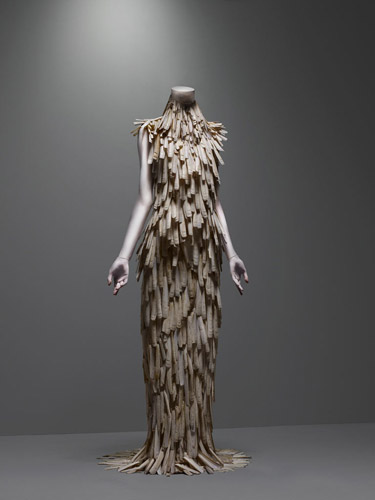

Alexander McQueen VOSS Razor-clam shell dress – Met Museum
Look 33 was a white column dress embellished with 1,200 razor clam shells that had been stripped, revarnished, then drilled and sewn to the canvas base of the garment with monofilament. Erin O’Connor, who modelled the dress, told photographer Nick Knight: “Before I go out, he grabs me by the clam and says ‘I want you to rip the dress off’, and I had worried that it looked like I was in some way a victim of being in that mind set, but it was completely the opposite of that. It looked like I was stripping away the pain and the armour.”
During an interview with WWD in 2000, McQueen revealed he was inspired to make the dress after a walk on the beach in Norfolk, where “there were thousands of razor clam shells. They were so beautiful, I thought I have to do something with them. So, we decided to make a dress out of them… the shells had outlived their usefulness on the beach, so we put them to another use on a dress. Then Erin came out and trashed the dress, so their usefulness was over once again. Kind of like fashion, really.”

Alexander McQueen VOSS SS01 Mussel Bodice Vertical – V&A Museum
In Look 65, McQueen utilised shells again, this time 80 oyster shells for an underdress. The overdress was made from a Japanese screen embroidered with flowers and birds that McQueen had purchased at the Saint Ouen flea market in Paris. He fused the crumbling fabric to cotton and silk to stabilise its shape. The dresses were accessorised with a neckpiece made from silver and Tahitian black pearl by Shaun Leane, with pointed silver branches that curled up uncomfortably over the wearer’s neck and face, forcing her to hold her head carefully. Model Laura Morgan undertook the challenge of wearing a cuirass made completely out of glass by East London manufacturer Colombia Glassworks. The breastplate stood out in the collection for its crimson colouring and resemblance to flesh and blood. Morgan later recalled the fear she felt wearing that piece, as she was told before walking the catwalk, “If you trip, you’re a goner!” The delicacy and fragility of this piece tied thematically to the pressure and sensitivity of mental health and the constant need to keep oneself together to avoid breaking down.
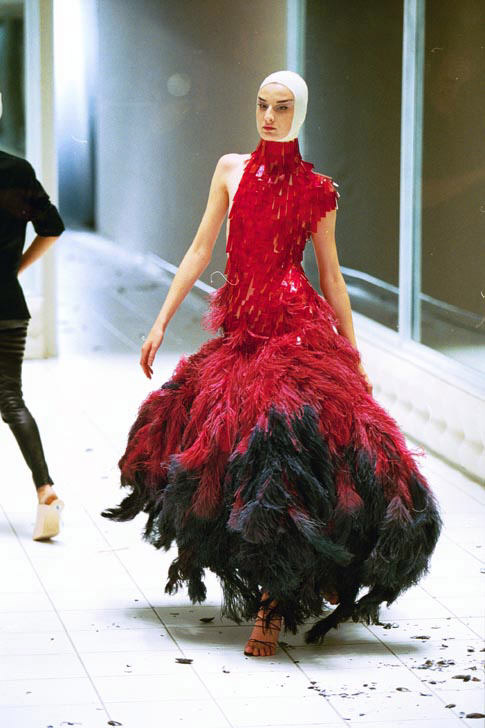
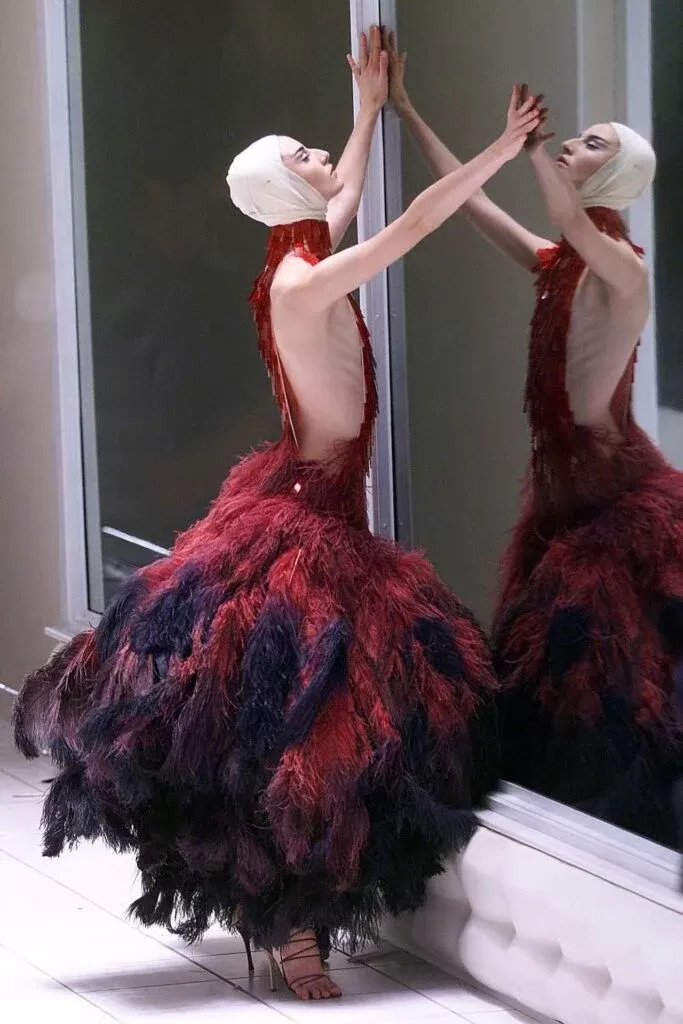
Alexander McQueen VOSS SS01 Red and black feathers dress – Met Museum
The finale look saw O’Connor return to the runway in a gown with an asymmetric bodice made from two thousand hand painted red microscope slides. The dress took six weeks to make and featured a voluminous skirt of dyed red ostrich feathers that cascaded into black before reaching the floor. The medical slides were used to invoke the idea of a body being studied under a microscope, and McQueen chose red because “there’s blood beneath every layer of skin.”

Alexander Mc Queen VOSS SS01 – Nss Magazine
Once the models had left the catwalk and the lights had gone down, one would assume the show was over. Instead, the lights flashed back on to reveal a box smashing open and British writer Michelle Olley draped naked on a chaise lounge, wearing a silver respirator mask and 250 moths and butterflies flying off of her. In diary entries donated to The MET Museum, Olley described how she had to wait hours in the box and how she couldn’t move so as to avoid maiming the insects. The temperature had to be kept cold to keep the moths placid: “Cold air is being piped in, as when the lights go on at showtime, it will get really hot. The cold air is giving me goosebumps and making the glue/moth parts all around my body really itchy. My head’s hot, my body’s freezing.” The visual was a direct recreation of a 1983 photograph by Joel-Peter Witkin named Sanitarium, and created a sense of awe and shock amongst the audience.

Alexander Mcqueen Voss SS01 – Nss Magazine
This year marks twenty five years since the Voss show, a spectacle yet to be rivalled by any other designer, perhaps only by McQueen himself. The collection explored mental health, bodily perfection, and the use of the natural world in design, themes that feel very current and perhaps ahead of their time when Voss debuted. The question that McQueen’s collection poses still makes us ponder:
What is the true nature of beauty?